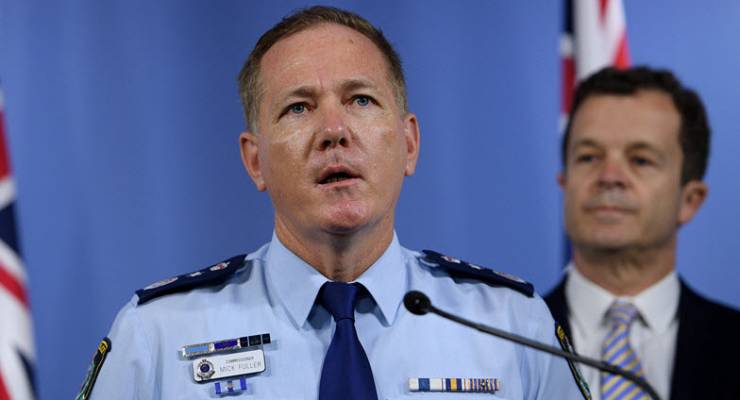
NSW Police Commissioner Mick Fuller
Imagine, a knock at the door. Five police officers stand outside demanding you take a psychiatric assessment.
Sounds like the sort of thing you’d expect from a police state. Certainly not something you’d find in a modern liberal democracy like Australia, right?
Yet according to Queensland lawyer Chris Nyst that’s allegedly what happened to one new client who turned up at his office.
Even more alarmingly, according to Nyst, his client “… had recently made a number of official complaints about the behaviour of a certain public servant, who he contended had been abusing his powers in the line of duty”.
The incident has raised serious concerns relating to the protection of civil liberties.
Apparently, Nyst’s client had somehow come to the attention of Queensland’s Fixated Threat Assessment Centre (QFTAC.) According to Nyst, QFTAC “… is an agency staffed by Queensland Police officers and clinicians from the Queensland Forensics Mental Health Service to identify people who are thought to ‘fixate’ on government officials and other public identities”.
Before the Lindt cafe seige committed by Man Haron Monis, QFTAC was one of only two such law enforcement forensic psychiatric threat assessment units in the world. In late April 2017, the New South Wales state government established the Fixated Person’s Unit, which has resulted in at least six charges and tens of dozens of people being investigated. Victoria has also announced the establishment of a Fixated Threat Assessment Centre in recent days.
How does this breed of police agency operate?
How exactly Nyst’s client came to the attention of police remains a mystery for now. Did Nyst’s client come to QFTAC’s attention via social media posts, a tattling colleague, or via a concerned family member? So far, that information hasn’t been made public.
A general request for public information to Queensland Police Service’s media liaison regarding QFTAC’s scope and method of operation received a response directing further enquiries to the Right to Information Unit.
What we do currently know is that, after the incident, Nyst’s client felt it necessary to seek legal advice.
How QFTAC discerns between the committed individual exercising their democratic right to engagement with public officials, versus justifiably worrying threat actors, is yet another unknown.
Interestingly, the 2015 QPS Violent Confrontations Review also found that over a 12-month period, almost half of people referred to the unit had a serious mental illness; 16% of all cases were considered high risk; 50% were considered moderate risk.
QPS doesn’t reveal how many completely mentally healthy, low-risk individuals were referred to the unit for making complaints about public servants and politicians. Can one assume 34% of people referred to QFTAC had little or no mental health issue and posed no threat at all?
The existence of pre-crime units such as QFTAC raises thorny questions about who can refer a person for assessment and the potential for over-policing of mentally unwell individuals. It also creates a range of possibilities for abuse of the system: a potentially Kafka-esque system of referring activists and whistleblowers who rock the boat to enhanced surveillance by law enforcement and mental health services.
Could their scope be expanded?
While the need to identify potential lone wolf terrorists is a pressing issue for both state and federal law enforcement agencies, it remains to be seen if QFTAC has implemented the advice in the 2014/15 the Queensland Police Service (QPS) review into violent confrontations, which recommended “extending the Queensland Fixed Threat Assessment Centre (QFTAC) principles to more than just Public Office Holders, identifying persons involved in domestic violence at risk of escalating to a crisis point, (for example rejected stalking and homicide.)”
It would be excellent to ensure people other just law makers and celebrities receive appropriate protection from stalkers and violently fixated individuals. Like ex-partners. Which seems like a rather a pressing issue, considering 18 Queensland women were killed as a result of domestic violence in 2016/17. Meanwhile, the number of high-profile people, public servants or government officials who died as a result of terrorism in Queensland in the last decade? Zero.
When NSW’s Fixated Person’s Unit was established earlier this year, NSW Police Commissioner Mick Fuller stated that if family, friends or work colleagues called about a person of interest, they wouldn’t necessarily “kick your door down”.
So have doors been kicked down as a result of concerned citizens asking a few too many questions? So far no oversight reporting mechanisms have been publicly detailed for QFTAC, NSW’s Fixated Persons Unit, or Victoria’s new Fixated Threat Assessment Centre.







As ever, and as always, any power a government assumes for itself or grants to its agents will be abused. Will a No supporting public servant or police officer use it to harass Yes voters who are critical of Lyle Shelton or Canadian Dickhead Dad? You betcha.
‘The Guardians (of the Realm – LWT ’71)’?
Why worry, as if ‘the police’ and their political masters ever get anything wrong…..?
Kafkaesque doesn’t even come close, does it.
I’d have to assume that any journalist following a lead on public corruption would have to fall foul of these units.
No more exposes Kate McClymont, we’ve locked you away because we think you might commit a crime against Eddie Obeid.
Minority Report – has a Hollywood feel. SMART TV’s watching us next?
A whistle blower would be the perfect example of someone requiring attention – after all, they are suggesting that their superiors are being naughty.
Lese majeste needs to be enshrined in Law, toot sweet, as well as a regulation length of forelock, for the tugging thereof.
It wasn’t that long ago (certainly up until the 80s) in Qld that a police sergeant had the authority to declare someone insane and sent to an asylum.
Must be all that sun. Or something in the air?